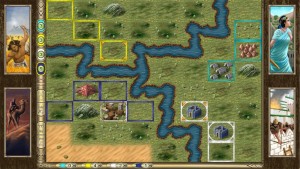Game Review: Bronze (Win PC)
 Shrapnel Games has a reputation for publishing high quality historical wargames (WWII versions of Steel Panthers, among others) as well as a smattering of other strategic titles (Dominions 3, Weird Worlds: Return to Infinite Space). One of their most recent releases is a downloadable game entitled Bronze, a strategy title set in ancient Mesopotamia. With simple rules and goals based around placing tiles for area control, it plays much like an abstract boardgame. With numerous campaign modes, flavor text full of historical facts, and the ability to play solo or hotseat multiplayer in randomly generated maps, Bronze shows surprising depth for it simple rules. There is something gripping about its simplicity that draws you in and leaves you wanting to play “just one more” five or ten minute game.
Shrapnel Games has a reputation for publishing high quality historical wargames (WWII versions of Steel Panthers, among others) as well as a smattering of other strategic titles (Dominions 3, Weird Worlds: Return to Infinite Space). One of their most recent releases is a downloadable game entitled Bronze, a strategy title set in ancient Mesopotamia. With simple rules and goals based around placing tiles for area control, it plays much like an abstract boardgame. With numerous campaign modes, flavor text full of historical facts, and the ability to play solo or hotseat multiplayer in randomly generated maps, Bronze shows surprising depth for it simple rules. There is something gripping about its simplicity that draws you in and leaves you wanting to play “just one more” five or ten minute game.
The game is introduced through a series of tutorials. Players take turns placing tiles onto a map containing farmland, rivers, swamps, hills, and metal resources. Placing (basically empty) farm tiles and mines (only adjacent to metal resources) earns a player money which can be used on later turns to place special building tiles. Buildings can be placed in adjacent empty territory, or in open farm spaces that have already been claimed by one’s side. Building special powers run the gamut of claiming large swaths of unclaimed territory, to aggressively taking over adjacent enemy buildings, to protecting one’s buildings from further takeover. Players continue to take turns placing tiles until the board is completely filled. The player with the most controlled spaces wins the game.
With such simple rules, it may seem to make for an uninteresting game, but the placement of resources, and timing of when to cross rivers give players plenty of food for strategic thought. Some setups have players battling to circle around each other, blocking out territory into which to expand. Other setups have plenty of infighting with players attempting to aggressively invade into each other’s territories using tiles that attack and control one’s opponents’ tiles.
There are multiple civilizations in the game, each with different buildings available. Some civilizations have similar buildings available, but have different building costs. This gives the game a nice variety. Playing as the Gutians, one must expand quickly since they have no defensive buildings and only one offensive (although free) building available. Meanwhile, the Akkadians only have one main offensive building. It is expensive, but manages to grab land, attack, and defend buildings all at once.
Interspersed through the campaigns and on the various splash screens are plenty of bits of information and background on the Bronze age and the many civilizations that lived in Mesopotamia during that time. Not since the early Civilization titles have I felt that I was learning so much history as I played. None of it is intrusive, and isn’t required to play, but it helps immensely to hold together the otherwise thin theme of the game. With many, many campaigns and challenges to face, it is far too easy to lose an hour or two playing “just one more game” that lasts ten minutes or less.

Kid Factor: As a fairly dry strategy game, it may not interest the very young. There is text all over the place, but since it is primarily background material, almost none of it is required reading. The harsher bits of the cultures of each empire presented tend to be glossed over, so there is very little to be concerned about. Given the required strategy involved, the game would fit well with any kid that can competently play chess. I suspect early teens would be a good starting point.





Discussion Area - Leave a Comment